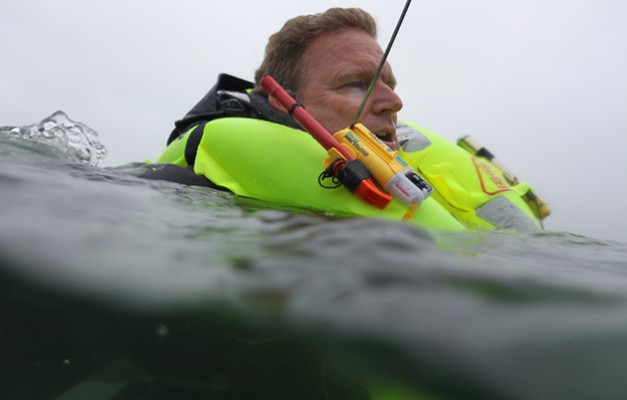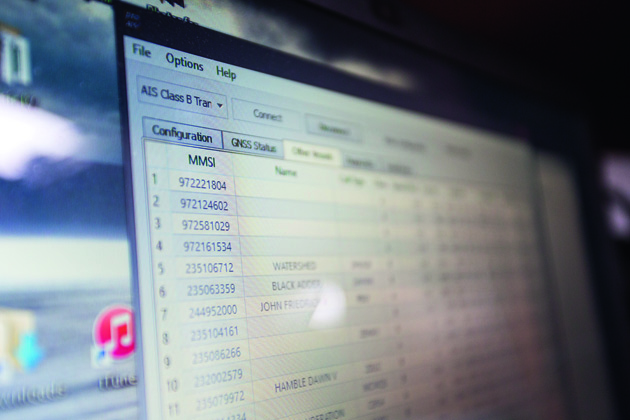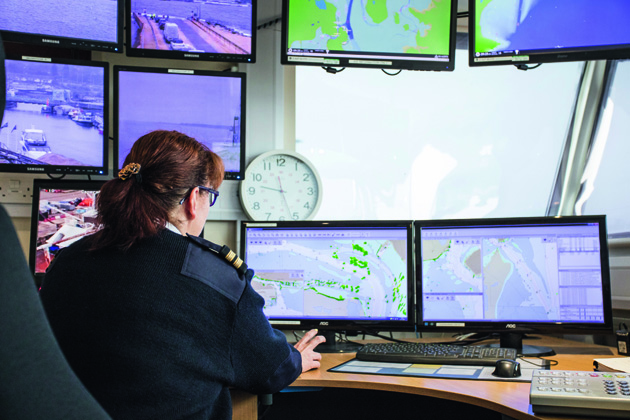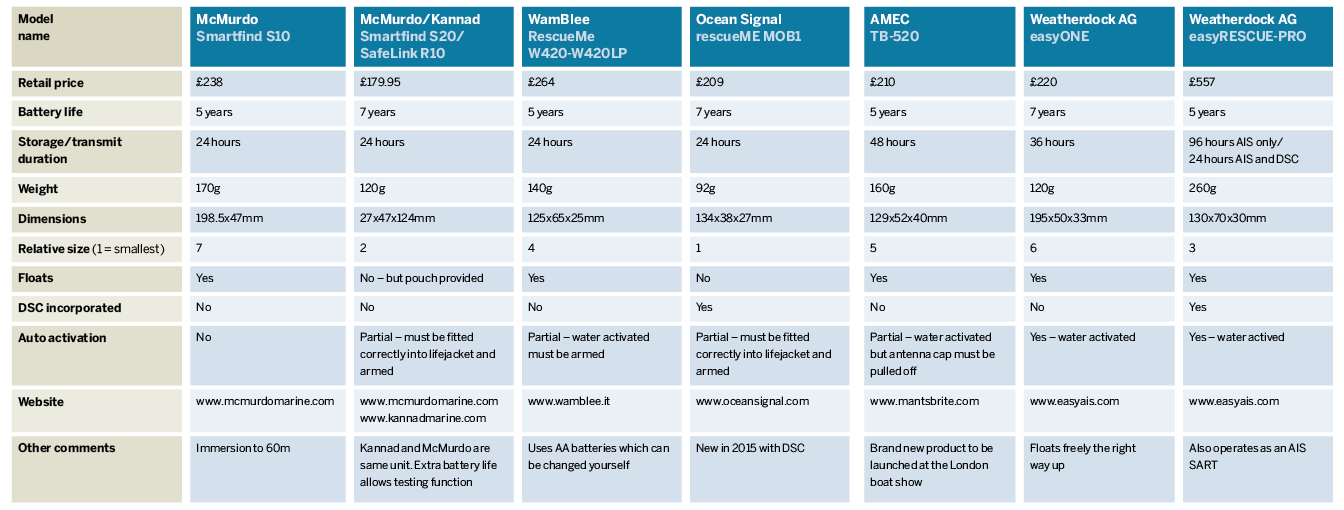These AIS MOB devices can alert your yacht, and others close by, to a man overboard. Pip Hare tests a selection of the latest models and considers the search and rescue options
Tested: AIS MOB devices – help your crew to save your life if you should go overboard
‘All ships’ alerts
Two devices, easyRESCUEpro and MOB1 incorporate a DSC alerting function, which allows the unit to be paired to a mother radio set on board your vessel. Upon activation they automatically send a closed loop (unit to unit only) alert to the mother set detailing MOB information. Both units were straightforward to program and sent test DSC alerts.
The MOB1 can also send a manually activated ‘All ships’ DSC alert. The easyRESCUEpro offers a more comprehensive system: it first sends a closed loop alert to your mother ship. If this alert is acknowledged you will receive an acoustic signal from the AIS device. If, however, no acknowledgment is made within five minutes, then the device will automatically switch to an ‘All ships’ transmission, which will carry on until acknowledged by another vessel.
The easyRESCUEpro is a popular commercial and military choice. It is designed to be used both as a personal device and as an AIS SART for a liferaft. It is also the only unit able to receive a DSC acknowledgement, so manufacturer Weatherdock claims it is GMDSS (Global Maritime Distress and Safety System) compliant – which in plain English means it is the only one that is actually a recognised way of calling for help.
However, this is the heaviest and most expensive unit (more than double the price of the smaller devices tested).
Calling for help
You may notice I refer to the sets as AIS devices and not beacons. This subtle difference in name is important. A beacon is an internationally recognised means of signalling distress, whereas an AIS personal locator device is not. The beacon says: ‘I am here and I need your help’, the device just says: ‘I am here’.
Further to this fact, we must also consider who is going to notice when one of these devices goes off and what they actually see.
Since the launch of AIS locator devices in 2011, the rate of development of this product has been quite a bit faster than the infrastructure designed to support them.
All personal devices are identified by a unique ID that starts with ‘972’. When the AIS devices first came out AIS equipped chart plotters displayed them as vessels. The MOB symbol of a red circle with a red X inside came out a year or so later, and the specification for sets to make an audible alert is very recent.
Although manufacturers have been quick to incorporate new features into plotters there is no requirement for old AIS receivers or plotters to be upgraded to new software acknowledging the 972 symbol or the audible alert. It is down to the individual owner to decide whether to make these changes.
I found a range of results in my testing. Some older sets even with recent software updates are not able to display the MOB symbol. Not all sets, whether new or old, include the sentence MOB TEST when test mode is activated. And if the AIS receivers and chart plotters are different units, both may need software updates.
The answer to this is clear – if you are going to carry a personal AIS device you must always test it against the boat on which you are sailing to find out exactly what will be displayed on activation and if an audible alarm will be sounded.
As someone who sails regularly double-handed I consider the audible alarm function an essential component. If your AIS plotter is not able to produce an audible alarm then the DSC-capable AIS MOB devices from Ocean Signal and Weatherdock could provide an alternative alerting system. Wamblee also have a DSC model, the W460.
Therefore, although many vessels now carry AIS, it is not safe to assume that every vessel within range will see, understand or react to your MOB device. And as the most likely people to rescue you, it is essential your own crew are aware of the capabilities of your own device.
The rescue services’ response
In understanding the scope of AIS MOB devices it is also important to know how AIS is interpreted by the people who manage our coastline and our rescue services.
There is currently no requirement for HM Coastguard shore stations to receive alarms if an AIS device is activated. The coastguard uses AIS in its control rooms as a situational awareness tool, but its AIS software is not currently able to display the MOB symbol on receipt of a 972 AIS signal. On its screens, an AIS MOB device will show up as a coloured triangle like all other AIS-equipped vessels.
The RNLI is in the process of installing AIS on all of its lifeboats, however it envisages it will be three years before the crew and fleet are fully AIS-functional and trained.
Until then, the advice from both services is that ‘AIS is incorporated into search and rescue wherever possible, but the AIS location devices should be considered as part of a package of safety equipment and not solely relied upon. Don’t forget the traditional means of calling for help such as DSC if you wish to guarantee your call reaches the search and rescue authorities.’
Among the other people who definitely can see AIS devices are the various Vessel Traffic Services around the UK. I worked with Poole Harbour Commissioners during my testing and had a look in their control room.
Captain Brian Murphy, Poole’s harbour master, told me his VTS staff will report any AIS MOB alerts directly to the Coastguard. In many cases, particularly in estuaries and close to the land, VTS have greater AIS coverage than the coastguard, so are more likely to pick up alerts.
Conclusion
When choosing one of these devices over a 406 MHz beacon, you are consciously giving the responsibility of your rescue to your crew. Naturally they can alert the authorities as well as coming to your aid, however only when they notice you have gone.
There is much talk about combining a 406 MHz beacon with the AIS locator device. The sticking point here is that 406 MHz devices are not allowed to be automatically activated – so currently the two items cannot be easily combined.
Chris Hoffman, chairman of the Radio Technical Commission for Maritime Services (RTCM) in the US, told me that they are in the process of writing the first specification that will allow the combination of the two and that we may see these products on the market in the US in 2017. However, there are currently no plans for a European specification, so the timing of their introduction in the UK and Europe is unclear at present.
If you are waiting for the combination AIS/406 devices to make it onto the market before investing in an MOB alerting system, I would think again. Technology is moving on at pace and who knows what the world of tracking and communications will look like in four years’ time – all lifejackets may automatically come with tracking chips.
Today, if you sail regularly with crew on a vessel fitted with AIS, I have no doubt these small and brilliant devices might one day save your life.








